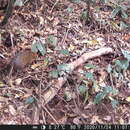mk
имиња во трошки


Other common names for R. cirnei are giant elephant shrews and giant sengis.
Checkered elephant shrews use visual perception in territorial encounters but also use scent signals to communicate. The scent gland is located just behind the anus and is used to mark territories. When foraging with other checkered elephant shrews, they make continuous squeals and squeaks to maintain group unity. When checkered elephant shrews are alarmed they slap their tail on the ground or tail-rap.
Communication Channels: visual ; tactile ; acoustic ; chemical
Perception Channels: visual ; tactile ; acoustic ; chemical
The IUCN places R. cirnei in the vulnerable threat category. Not enough research has been done to determine its true conservation status.
US Federal List: no special status
CITES: no special status
IUCN Red List of Threatened Species: near threatened
There are no known negative impacts of checkered elephant shrews on humans.
Some people from East Africa use elephant shrews as a source of food.
Positive Impacts: food
Checkered elephant shrews are insectivores and impact insect communities through predation.
Checkered elephant shrews are invertivores. They eat invertebrates such as ants, termites, centipedes, earthworms, and beetles and their larvae. They also will eat small mammals, amphibians, mollusks, birds, and bird eggs.
Animal Foods: birds; mammals; amphibians; eggs; insects; terrestrial non-insect arthropods; mollusks; terrestrial worms
Primary Diet: carnivore (Insectivore , Eats non-insect arthropods)
Checkered elephant shrews are found only in central and southeast Africa, in the countries of Uganda, southern Tanzania, northern Zaire, northern and eastern Democratic Republic of Congo, northern and central Mozambique, northeastern Zambia, and Malawi.
Biogeographic Regions: ethiopian (Native )
Checkered elephant shrews prefer lowland and montane tropical rainforests. They are also found in forest mosaics (open woodlands and woodlands mosaics), grasslands, riparian forests, shrublands, bushlands, and croplands. Checkered elephant shrews are well adapted to areas where there is a plentiful supply of food and water year round.
Habitat Regions: tropical ; terrestrial
Terrestrial Biomes: savanna or grassland ; forest ; rainforest ; scrub forest ; mountains
Other Habitat Features: agricultural
Nothing is known about the lifespan of checkered elephant shrews lifespan. In general, members of the genus Rhynchocyon live to about four of five years old.
Typical lifespan
Status: wild: 4 to 5 years.
Average lifespan
Status: wild: 4-5 years.
Checkered elephant shrews are one of the largest elephant shrews, ranging in body length from 22.9 to 30.5 centimeters and tail length from 17.8 to 25.4 centimeters. They weigh 410 to 550 grams. The coat has several dark stripes that run on either side of the body. A “checkered” pattern is created on the back with alternating chestnut and off-white colors. The background color ranges from beige to yellowish brown to dark brown. Members of the genus Rhynchocyon tend to have bright colors and patterns on their fur. The hind legs are longer than the fore limbs, resulting in a hunchbacked posture. Their forelimbs have three long claws used to excavate small holes in the ground. Checkered elephant shrews also have long and tapering tails, with scent glands located just behind the anus. The nose is elongated and the tongue, which is used to pick up small food items, extends well beyond the edge of the nose. The long proboscis continually twitches in a hesitant, circular motion. It is used as a tool and sense organ. The nostrils are located on the forward end of the snout while long sensory whiskers arise from its base.
General traits for the order Macroscelidea include a relatively long digestive tract with a caecum and several distinctive features of the reproductive tract. Male macroscelids have larger canine teeth than females.
Range mass: 408 to 550 g.
Range length: 22.9 to 30.5 cm.
Other Physical Features: endothermic ; homoiothermic; bilateral symmetry
Sexual Dimorphism: sexes shaped differently
Snakes and birds of prey are the primary predators of checkered elephant shrews. Checkered elephant shrews are eaten in certain areas of eastern Africa by humans. They are cryptically colored and help to warn each other about the presence of predators through vocal signals.
Known Predators:
Anti-predator Adaptations: cryptic
Checkered elephant shrews form monogamous pairs for life.
Mating System: monogamous
The number of offspring is uncertain. One source states that they have one offspring at a time. Another reports that 4 specimens from Uganda and Zambia had litters of 2 offspring. The British Museum of Natural History has a specimen from which 3 fetuses were removed. A female is able to gestate and lactate at the same time, and females give birth 4 to 5 times a year. Young elephant shrews are born with hair. Rhynchocyon cirnei breeds throughout the year. The gestation period lasts for a period of 42 days.
Breeding interval: Breeding occurs four to five times a year in checkered elephant shrews.
Breeding season: Checkered elephant shrews mate year-round.
Range number of offspring: 1 to 3.
Average gestation period: 42 days.
Range weaning age: 2 (high) weeks.
Range time to independence: 5 to 10 weeks.
Key Reproductive Features: iteroparous ; year-round breeding ; gonochoric/gonochoristic/dioecious (sexes separate); sexual ; viviparous ; post-partum estrous
Newborn checkered elephant shrews stay in the nest for two weeks. After this time the young are fully weaned but follow the mother while she forages. The youngster is able to survive on its own five days after it leaves the nest, but stays with the parents for an extra 5 to 10 weeks after weaning, while trying to establish its territory. Young leave the parents' supervision when they find a territory and a mate.
Parental Investment: precocial ; pre-fertilization (Provisioning, Protecting: Female); pre-hatching/birth (Provisioning: Female, Protecting: Female); pre-weaning/fledging (Provisioning: Female, Protecting: Male, Female); pre-independence (Protecting: Male, Female)